Statistics show that on average every driver will experience up to 5 flat tires in their lifetime. To make matters worse for when you do have a flat tire, you just might discover that that new car you bought recently does not come with a spare tire. In fact, Torque News writer John Goreham recently posted how that vehicle makers are stealing the spares from EV owners.
The reasons for lack of a spare tire range from they weigh too much for the newer EV vehicles where range anxiety is a concern of green car enthusiasts, to unsubstantiated claims that today the chances of ever having a flat are too remote to justify the continued practice of providing all vehicles with even a smaller temp spare for emergencies. Codswallop!
According to multiple sources listed about flat tires, in the United States alone, approximately 7 tire punctures occur every second, resulting in 220 million flat tires per year.
Your Options For a Flat Tire Problem
So how can you prepare yourself for those times you will have a flat, but your car did not come with a spare tire? You basically have 4 options:
1. Buy your own spare from a company that deals in spares designed for your model of car.
2. Outfit your car with tires designed to run even when flat so that you can make it to a service station or tire center for repair or replacement.
3. Buy into a roadside assistance program that will send a service truck to your vehicle that will either repair the flat on the spot or provide a spare tire.
4. DIY with a flat tire sealant that will keep your tire adequately inflated until you can make it to a tire service center.
In this article we will look at option number four.
What Consumer Reports Has to Say About Flat Tire Sealants
Sealant Kits
Sealant kits are designed for flat tires that result from a puncture wound to the tire such as running over a nail or some other relatively small and narrow sharp object.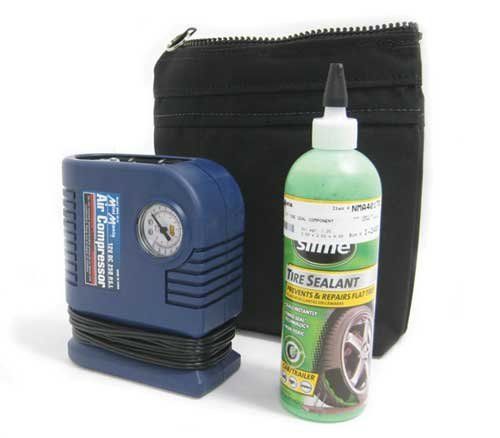 If the damage is much bigger than that such as a crack or larger hole, sealant kits don’t work.
If the damage is much bigger than that such as a crack or larger hole, sealant kits don’t work.
Typical sealant kits most motorists think of consist of just a pressurized can containing a gooey sealant that can temporarily seal a hole as the pressure within the can partially inflates the tire and forces the sealant into the puncture. However, other kits are more involved and include a small compressor for inflating the tire fully. As such, compressor kits are the more expensive option running anywhere between $24 to $80, whereas a pressurized can of sealant usually runs between $7 and $20.
There is also a third type of sealant system that consists of a liquid sealant squirted by hand through the valve stem of a flat tire and then inflated with a compressor; however the compressor is not included. The price range of a bottle of this type of sealant runs between $9 to $14.
Cons of Sealants Regardless of Repair Kit Type
• They are messy and can add to the cost when the tire is eventually repaired.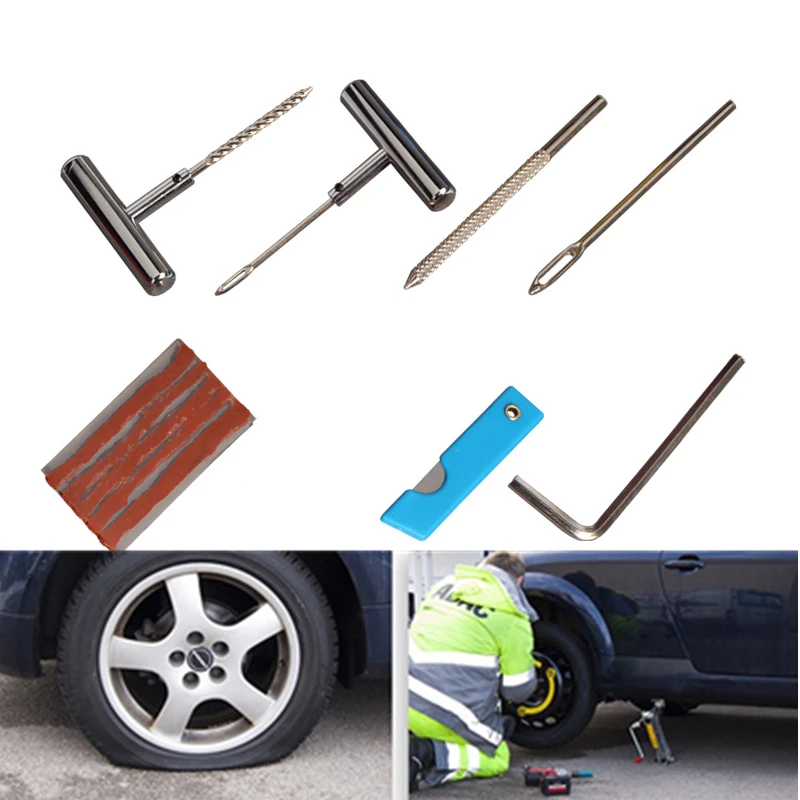
• Sealants can gum-up your tire pressure monitoring system.
• Limited to puncture holes 6mm or less is diameter.
• Might not work if multiple holes are involved.
• Limited distance of travel after sealing.
• Have to drive relatively slowly after sealing.
• May have a limited shelf life.
• Pressurized cans of sealant are at risk of exploding in a hot car.
Despite the cons of sealants, Consumer Reports recommends that choices that include a compressor are the ones more likely to result in success. Depending on how bad the leak is and how well (or not) it seals the hole, repeated use of a compressor can help you limp your way back home or to help.
Flat Tire Repair Testing Procedures
Tests were done using brand new tires with both 2.4 mm and 5.8 mm diameter nails welded to a flat metal plate with the car lowered by a lift so as to puncture all tires equally. After the punctured tires became flat, the sealant and sealant kits were used separately, with the tires inflated to 35 pounds of pressure and driven a short distance to ensure the insides of the tires were adequately coated with the sealant.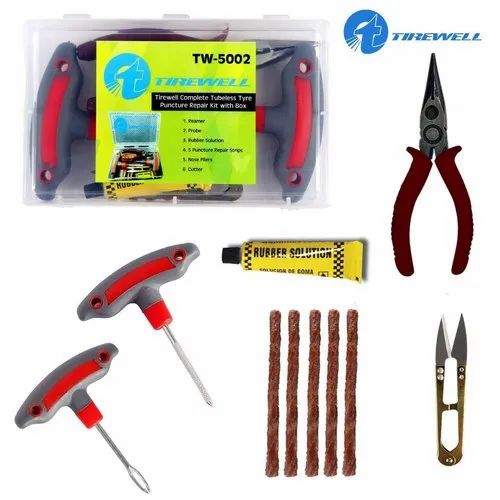
If there was no loss of air pressure, the tires were then put on the road for 50 miles, parked overnight, and the tire pressure rechecked the next day.
Tire Sealant Product and Kit Reviews
Pressurized Can Sealants
Super Tech Tire Sealant & Inflator ($7 at Walmart) ---available from Walmart and the least expensive product tested, the analysts from CR found that this one did not work---even with the smallest puncture of 2.4 mm. Similar to the Fix-a-Flat product, a compressor was needed to top off the tire pressure to the car’s recommended pressure. But, because of its poor test performance, the analysts recommend considering any of the other products evaluated over this bargain-priced sealant.
Fix-a-Flat ($8 to $20 at Walmart, AutoZone, Amazon, Home Depot, Target and Fix-a-Flat)---in spite of being a common name in pressurized-can sealants, it’s tested performance is quite poor, which greatly offsets the convenience of being the among the easiest to use.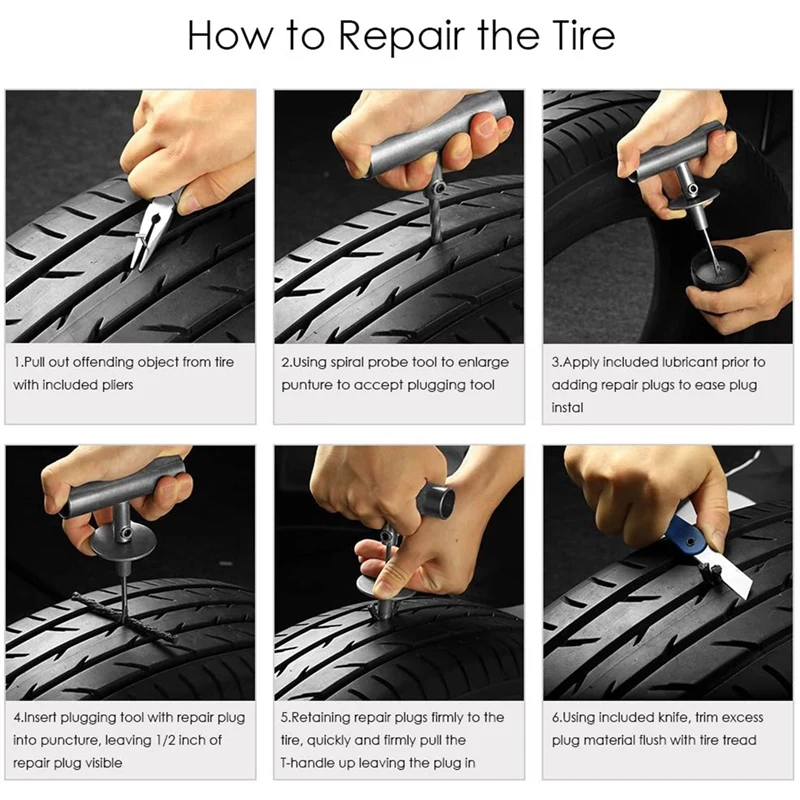 According to CR, “Fix-a-Flat was able to seal the smaller 2.4-mm puncture with a minor loss of pressure in a 24-hour period. However, it could not seal the 5.8-mm puncture, and it could not inflate the tire without topping off with a compressor.” Another mark against it is that if you drive a truck or SUV you will have to buy the more expensive larger can size.
According to CR, “Fix-a-Flat was able to seal the smaller 2.4-mm puncture with a minor loss of pressure in a 24-hour period. However, it could not seal the 5.8-mm puncture, and it could not inflate the tire without topping off with a compressor.” Another mark against it is that if you drive a truck or SUV you will have to buy the more expensive larger can size.
Liquid Tire Sealants
Slime Tire Sealant Thru-Core Technology ($9 to $14 found at Ace Hardware, AutoZone and Walmart) --- Like the Fix-a-Flat pressurized can, this non-pressurized sealant was able to seal a 2.4 mm hole, but it failed on the 5.8 mm puncture. Plus, it requires a portable tire inflator, making the Fix-a-Flat pressurized can a better (but tire pressure limiting) inexpensive solution.
Tire Sealant Kits (Compressor Containing)
airMan ResQ Pro + ($80 found at Grainger)---a kit that has the compressor doing the hard part for you by feeding the sealant directly into the tire, this kit was found to easily seal the large 5. 8-mm puncture with the added plus that it inflated flat tires quicker than the other products tested. A no-assembly, easy-to-use, self-contained and complete kit, this was the favorite among the analysts.
8-mm puncture with the added plus that it inflated flat tires quicker than the other products tested. A no-assembly, easy-to-use, self-contained and complete kit, this was the favorite among the analysts.
airMan ResQ Tire Repair Kit ($55 at Amazon)---this little brother to the airMan ResQ Pro + has similar performance to its bigger brother, but it requires assembly of the sealant container to the compressor as well as disassembly afterward. The opinion of the analysts is that spending the extra $25 makes the Pro+ a better choice of the two.
Slime Smart Spair Emergency Flat Tire Repair Kit ($24 to $40 found at Walmart, Amazon, Ace Hardware, Advance Auto Parts, Sportsman’s Warehouse and Slime)---this is a less-expensive compressor kit that was successful in sealing a large 5.8-mm puncture with ease. However, the sealant is not self-feeding via the compressor and thereby requires removing the valve stem and then squirting the sealant into the flat tire by hand.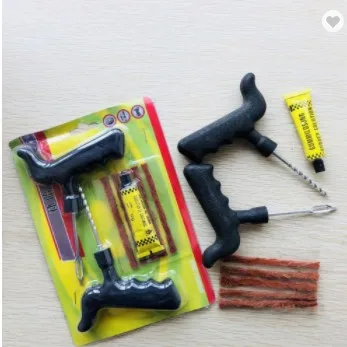 Being more cumbersome to use than the two aforementioned airMan products, the analysts did not view the cost savings worth the added bother.
Being more cumbersome to use than the two aforementioned airMan products, the analysts did not view the cost savings worth the added bother.
Slime Flat Tire Repair Kit Digital Series ($35 to $55 found at Walmart, AutoZone and Amazon)---although containing a built-in pressure gauge and feeding the sealant into the tire via the compressor like the airMan kits, the analysts reported mixed reviews of its performance: it would seal both 2.4 mm and 5.8 mm punctures---but not always, and air loss after sealing was not the best. They determined that either of the two previously listed airMan products would be their preferred choice over this tire repair kit product .
Final Determination
The analysts recommend kits containing a compressor over just sealants in either bottle form or pressurized cans. They observed that:
• Tire sealant kits were far superior to pressurized-can sealants.
• The kits were able to seal a larger puncture and included a compressor to inflate the flat tire to the recommended tire pressure.
• Pressured cans of sealant will not inflate tires adequately enough for safe road travel.
• With the exception of the Super Tech Tire Sealant, both the Fix-a-Flat and the Slime Tire Sealant do seal at least the smaller of the puncture holes, but without a compressor handy (and because of the cons listed with pressurized can products) they are not recommended by the analysts of Consumer Reports.
Be sure to watch for additional future articles about saving on car repairs and tire repair and used car savings recommended from consumer testing services, as well as some DIY tips on fixing your car.
Coming Up Next: Consumer Reports Goes After Tesla and Beta 9 FSD.
Timothy Boyer is Torque News Tesla and EV reporter based in Cincinnati. Experienced with early car restorations, he regularly restores older vehicles with engine modifications for improved performance. Follow Tim on Twitter at @TimBoyerWrites for daily Tesla and electric vehicle news.
Photo by Kenan Reed on Unsplash
JB Tools Customer Satisfaction Guarantee: Although JB tools is often not an “authorized” re-seller of all the products it sells and is often not affiliated with the manufacturers or brands of the products it sells, JB Tools stands behind all of the products it sells, because the products JB Tools sells are genuine and authentic. Because JB Tools only sells genuine and authentic products, JB Tools offers its customers a 100% satisfaction guarantee. To ensure 100% customer satisfaction, JB Tools is committed to and strictly complies with its return policy, which offers replacement products to its customers (subject to product availability), or a full refund (less return shipping costs), at the customer’s option, and which you can access by clicking here.
Because JB Tools is an independent re-seller, JB Tools is able to offer the products it sells at the most competitive prices, resulting in substantial cost-savings passed directly to JB Tools’ customers. JB Tools prides itself in being a trusted, internet-based retailer that its customers can rely on for quality products at reasonable prices. JB Tools’ commitment to 100% customer satisfaction is unparalleled, which is why JB Tools offers its customers a best-in-class Warranty Program to all of its customers on all products sold by JB Tools. In the event a JB Tools customer believes that a product purchased from JB Tools has a defective condition and/or malfunctioning issue, JB Tools’ customers can rest assured JB Tools will work with its customers to ensure issues are resolved in accordance with JB Tools’ Warranty Program, which you can access by clicking here.
JB Tools Non-Affiliation Notice and Disclaimer: JB Tools holds itself out as neither the manufacturer, an affiliate of the manufacturer, or an “authorized” distributor of this product. By purchasing this product from JB Tools, purchasers may not be guaranteed any manufacturer-provided services offered by the manufacturer of this product (including any training or technical support that may otherwise be available). By purchasing this product from JB Tools, the manufacturers’ warranty, if any, potentially associated with the product may not be honored by the manufacturer. JB Tools provides this disclaimer to ensure there is no likelihood of confusion unduly influencing your decision to purchase this product, or any other, product from JB Tools, and to ensure there is no confusion as to the existence of any affiliation between JB Tools and the manufacturer of this product. However, JB Tools’ customers can rest assured that JB Tools stands behind its Warranty Program and its Manufacturer Matching Policy,100% of the time. Furthermore, in connection with JB Tools’ satisfaction guarantee, JB Tools matches the price and/or any promotion associated with its products.
4. What to do if a wheel tire is damaged
This vehicle is equipped with a tire pressure monitoring system (TPMS). This system monitors the pressure in all tires. If the warning light comes on and the message “CHECK TIRE PRESSURE” appears on the LCD, it means that at least one of the wheel tires is flat. If the vehicle is driven with a flat tire, the TPMS system will activate, warning the driver of low tire pressure with a low tire pressure indicator on the instrument panel. This system is only activated when the vehicle is moving at speeds above 25 km/h.
WARNING
If the low tire pressure warning light comes on while driving, slow down the vehicle and pull off the road to a safe place as soon as possible, avoiding active steering or heavy braking, then stop. Driving with a flat tire can cause permanent tire damage or increase tire damage. In addition, it can cause serious damage to the car due to an accident, as well as injuries of varying severity. Check the pressure in all four tires. To turn off the warning light, adjust the tire pressure to the recommended COLD tire pressure indicated on the vehicle information tag. If the light stays on after adjusting the pressure, the tire is damaged. You need to make repairs as described below.
If a wheel is replaced, the TPMS will not work and the low tire pressure warning light will flash for approximately one minute, after which it will remain on. Contact your Nissan dealership as soon as possible for a wheel replacement and/or system reset.
Replacing tires with ones that do not match the original ones may cause the TPMS system to malfunction.
Do not inject sealant liquids or aerosols into the tire as this may cause the pressure sensor to malfunction.
When using the emergency tire repair kit to repair minor punctures, contact your Nissan dealership to replace the TPMS sensor in addition to repairing or replacing the tire.
Nissan recommends using only Genuine Nissan Emergency Tire Repair Sealant supplied with the vehicle. Any other type of sealant can damage the tire valve seals, resulting in a loss of air pressure.
WARNING
After using the emergency tire repair kit to repair minor punctures, do not drive at speeds above 80 km/h.
Immediately after repairing a minor tire puncture, take the vehicle to a Nissan dealership to have the tire checked and repaired or replaced. The emergency tire repair kit does not permanently seal a damaged tire. Continued operation of the vehicle without thorough repair of the damaged tire may result in an accident.
When using the emergency tire repair kit to repair minor punctures, contact your Nissan dealership to replace the TPMS sensor in addition to repairing or replacing the tire.
Nissan recommends using only Genuine Nissan Emergency Tire Repair Sealant supplied with the vehicle. Any other type of sealant can damage the tire valve seals, resulting in a loss of air pressure.
This vehicle is not equipped with a spare wheel. Instead, it comes with an emergency tire repair kit. This kit can be used to temporarily repair minor tire damage.
If possible, it is preferable to use a tow truck to transport the vehicle to a location where full repair and replacement of a flat tire can be carried out. Using the emergency tire repair kit may cause the tire pressure sensor to malfunction and cause the low tire pressure warning light to illuminate on the instrument panel.
In the event of tire damage, follow the instructions below.
CAUTION
To prevent damage to the emergency tire repair kit during storage or use:
- Use the emergency tire repair kit for your vehicle only. Do not use the kit for other vehicles.
- Use the kit only to inflate your vehicle's tires and check tire pressure.
- Connect the compressor to the 12 V DC power socket of the car's electrical system.
- Keep the tire repair kit away from water or dirt.
- Do not disassemble or modify the tire repair kit.
- Do not drop or hit the tire repair kit.
Do not use the emergency tire repair kit in the following situations (contact your I/Evan dealership or recovery service):
- If the sealant is out of date (see the label on the sealant bottle).
- If the cut or puncture in the tire is approximately 6 mm or more.
- If the sidewall of the tire is damaged.
- If the car continued to move on a flat tire for a long time.
- If the tire has been stripped from the rim on the inside or outside.
- If the rim is damaged.
- If two or more tires are damaged.
1. Drive the vehicle carefully away from the road.
2. Switch on the hazard warning lights.
3. Stop the vehicle on level ground and apply the parking brake.
4. Move the "P" position switch on the selector lever to the park position.
5. Switch off the motor of the electric vehicle.
6. Raise the hood to alert other road users and roadside assistance personnel to your location.
7. Get the passengers out of the car and make sure they are all in a safe place away from the road and the car.
CAUTION
Make sure the parking brake is properly applied and the vehicle transmission is in park mode.
Do not repair a tire while the vehicle is on a sloping, icy or slippery surface. Is it dangerous!
Do not repair the tire if it was not possible to position the car at a sufficient distance from passing traffic. Wait for the arrival of roadside assistance.
Remove the emergency tire repair kit from the side compartment in the luggage compartment.
The emergency tire repair kit consists of the following components:
1. A bottle of tire sealant.
2. Air compressor.
3. Speed limit sticker.
If any foreign object (such as a screw or nail) is stuck in the tire, do not remove it.
Check the expiration date of the sealant (found on the tag on the sealant bottle). Do not use expired sealant!
CAUTION
Observe the following precautions when using tire repair sealant.
- Swallowing sealant is dangerous. If this happens, drink plenty of water immediately and seek medical attention as soon as possible.
- If sealant comes into contact with skin or eyes, rinse affected area with running water. If irritation occurs, seek medical attention.
Keep sealant out of reach of children.
The sealant from the tire repair kit may cause a tire pressure sensor to malfunction, causing the low tire pressure indicator on the dashboard to light up. The tire pressure sensor should be replaced as soon as possible.
Note
When repairing, do not remove the nail or screw that has penetrated the tire.
1. Open the air compressor cover and remove the speed limit sticker, then place it in the driver's field of vision to remind the vehicle of the speed limit with the repaired tire repair kit.
WARNING
Do not place a speed limit sticker on the steering wheel or instrument cluster.
2. Remove hose (1) and plug (2) from the air compressor. Remove the container holder cover from the air compressor.
3. Remove the sealant bottle cap. Screw the container onto the air compressor holder. (Do not remove the canister seal. When the canister is screwed on, the seal will break properly.)
4. Remove the cap from the flat tire valve.
5. Remove the protective cap (A) from the hose and screw the hose securely onto the tire valve. Make sure the pressure relief valve (B) is securely tightened. Make sure the air compressor switch is in the off (O) position, then insert the plug into the car socket.
6. Turn the electric vehicle's power switch to the "ACC" position. Then turn the air compressor switch to the on (“-”) position and inflate the tire to the pressure indicated on the information tag located on the B-pillar on the driver's side, or if this is not possible, to at least 180 kPa. Switch off the air compressor briefly to check the tire pressure with a pressure gauge. If the tire is inflated to a higher pressure than necessary, bleed the air using the pressure relief valve.
Note
The air compressor pressure gauge can show a pressure of 600 kPa for about 30 seconds from the moment the tire is inflated. The pressure gauge displays the pressure inside the sealant container. After the sealant is injected into the tire, the pressure on the gauge will decrease and the actual tire pressure will be displayed.
CAUTION
To avoid personal injury when using the tire repair kit:
- Tighten the compressor hose securely to the tire valve. Failure to do so may result in the sealant spraying into the air and contacting the eyes or skin.
- Do not stand directly next to a damaged tire during inflation, as there is a risk of bursting. If any cracks or bulges appear, turn off the compressor immediately.
If the tire pressure fails to inflate to 180 kPa within 10 minutes, the tire is badly damaged and cannot be repaired with a repair kit. Contact a Nissan dealer for assistance.
7. When the desired pressure is reached, switch off the compressor. If the tire cannot be inflated to the required pressure, the air compressor can be switched off when the minimum pressure of 180 kPa is reached. Remove the plug from the power outlet and quickly remove the hose from the wheel valve. Install the protective cap and valve cap. Properly fold the tire repair kit back into the luggage compartment.
CAUTION
To avoid personal injury, leave the sealant bottle screwed onto the compressor when installing the tire repair kit. Failure to do so may cause the sealant to spray into the air and come into contact with the eyes or skin.
8. Drive immediately for 10 minutes or 3 km at speeds up to 80 km/h.
9. After driving, make sure the air compressor switch is in the off position, then screw the hose securely onto the wheel valve. Check tire pressure with a compressor. A temporary tire repair can be considered complete if the tire pressure does not drop. Adjust the tire pressure to normal (the pressure value is indicated on the information tag located on the B-pillar on the driver's side).
10. If the tire pressure has dropped, repeat steps 5-9. If the tire pressure drops again or stays below 130 kPa, the tire cannot be repaired with the repair kit. Contact a Nissan dealer for assistance.
Note
Sealant bottle and hose cannot be reused to repair another punctured tire. You need to go to a Nissan dealership to have them replaced.
At the earliest opportunity, take your tire to a Nissan dealer for repair/replacement.
WARNING
After using the emergency kit to repair a minor puncture, do not exceed a speed of 80 km/h.
Immediately after repairing a puncture, take the tire to a Nissan dealership to have the tire repaired or replaced as soon as possible. The emergency tire repair kit does not permanently seal a punctured tire. Continued operation of the vehicle without overhauling the tire may cause an accident.
Do not inject sealant liquids or aerosols into the tire as this may cause the pressure sensor to malfunction.
When using the emergency tire repair kit to repair minor punctures, contact your Nissan dealership to replace the TPMS sensor in addition to repairing or replacing the tire.
Nissan recommends using only Genuine Nissan Emergency Tire Repair Sealant supplied with the vehicle. Any other type of sealant can damage the tire valve seals, resulting in a loss of air pressure.
02/22/2018
Despite the objective importance of the spare tire, not all drivers always have it with them. Some do not carry a spare tire out of hope or belief that their tires are invulnerable. Others deliberately take this step, as they stocked up with a special tool in advance, which, if necessary, can eliminate a tire puncture along the way. What else can be used and how to do it right? Let's figure it out.
Contents :
Conventionally, all methods for express tire repair can be divided into two categories:
Consider ways to restore a damaged tire on the road. The first three methods are temporary. The latter, with the right approach, allows you to completely restore the tire.
After removing the foreign object, the hole is processed with an awl with abrasive edges: this tool must be inserted into the puncture and cleaned and developed with intensive reciprocating movements several times. Then the raw rubber tow is removed from the package and inserted into the eye of the second awl so that both ends are the same length. The hole in the tire and the raw rubber is treated with an activator. Next, the awl is inserted into the puncture in such a way that small ends of the tourniquet, about a centimeter long, remain outside. After 5 minutes, the excess remaining on the surface is cut off. This method can also successfully eliminate small side cuts.
There is a technique that allows using wire and several bundles of raw rubber to get rid of even extensive side damage to tires. However, it is quite difficult to implement and not every driver will be able to implement it.
Consider a few well-known tools that are most widely used to repair punctures: